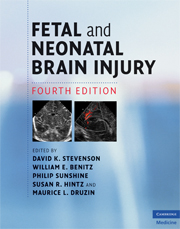Book contents
- Frontmatter
- Contents
- List of contributors
- Foreword
- Preface
- Section 1 Epidemiology, pathophysiology, and pathogenesis of fetal and neonatal brain injury
- Section 2 Pregnancy, labor, and delivery complications causing brain injury
- Section 3 Diagnosis of the infant with brain injury
- Section 4 Specific conditions associated with fetal and neonatal brain injury
- 22 Congenital malformations of the brain
- 23 Neurogenetic disorders of the brain
- 24 Hemorrhagic lesions of the central nervous system
- 25 Neonatal stroke
- 26 Hypoglycemia in the neonate
- 27 Hyperbilirubinemia and kernicterus
- 28 Polycythemia and fetal–maternal bleeding
- 29 Hydrops fetalis
- 30 Bacterial sepsis in the neonate
- 31 Neonatal bacterial meningitis
- 32 Neurological sequelae of congenital perinatal infection
- 33 Perinatal human immunodeficiency virus infection
- 34 Inborn errors of metabolism with features of hypoxic–ischemic encephalopathy
- 35 Acidosis and alkalosis
- 36 Meconium staining and the meconium aspiration syndrome
- 37 Persistent pulmonary hypertension of the newborn
- 38 Pediatric cardiac surgery: relevance to fetal and neonatal brain injury
- Section 5 Management of the depressed or neurologically dysfunctional neonate
- Section 6 Assessing outcome of the brain-injured infant
- Index
- Plate section
- References
27 - Hyperbilirubinemia and kernicterus
from Section 4 - Specific conditions associated with fetal and neonatal brain injury
Published online by Cambridge University Press: 12 January 2010
- Frontmatter
- Contents
- List of contributors
- Foreword
- Preface
- Section 1 Epidemiology, pathophysiology, and pathogenesis of fetal and neonatal brain injury
- Section 2 Pregnancy, labor, and delivery complications causing brain injury
- Section 3 Diagnosis of the infant with brain injury
- Section 4 Specific conditions associated with fetal and neonatal brain injury
- 22 Congenital malformations of the brain
- 23 Neurogenetic disorders of the brain
- 24 Hemorrhagic lesions of the central nervous system
- 25 Neonatal stroke
- 26 Hypoglycemia in the neonate
- 27 Hyperbilirubinemia and kernicterus
- 28 Polycythemia and fetal–maternal bleeding
- 29 Hydrops fetalis
- 30 Bacterial sepsis in the neonate
- 31 Neonatal bacterial meningitis
- 32 Neurological sequelae of congenital perinatal infection
- 33 Perinatal human immunodeficiency virus infection
- 34 Inborn errors of metabolism with features of hypoxic–ischemic encephalopathy
- 35 Acidosis and alkalosis
- 36 Meconium staining and the meconium aspiration syndrome
- 37 Persistent pulmonary hypertension of the newborn
- 38 Pediatric cardiac surgery: relevance to fetal and neonatal brain injury
- Section 5 Management of the depressed or neurologically dysfunctional neonate
- Section 6 Assessing outcome of the brain-injured infant
- Index
- Plate section
- References
Summary
Introduction
The term kernicterus was originally used to describe the deposition of bilirubin in the basal ganglia. It was first described in 1903 by Schmorl. More recently, the term has also been used in reference to the chronic and permanent clinical sequelae of bilirubin toxicity. For the acute manifestations of bilirubin toxicity, the term acute bilirubin encephalopathy or ABE has been adopted. Another acronym, BIND, has been adopted to describe any bilirubin-induced neurologic dysfunction. Although technically the diagnosis of kernicterus can only be confirmed at autopsy, brain magnetic resonance imaging (MRI) studies may now aid in the confirmation of the diagnosis in a living child with severe jaundice. The MRI signature for kernicterus includes high signal intensity on T1-weighted (T1W) images in the globus pallidus, internal capsule, thalamus, and hippocampi (Fig. 27.1). The associated T2W images have abnormal increased signal in the globus pallidus and thalamus in the same regions as the high signal on the T1W images (Fig. 27.2). Loss of demarcation between globus pallidus, internal capsule, and the anterior thalamus was the major finding. The source of these abnormal signals has not been definitively identified, and therefore the MRI findings should not be considered diagnostic in themselves, but only consistent with the diagnosis of kernicterus in the context of severe neonatal jaundice and the acute and chronic clinical features of bilirubin toxicity (Table 27.1).
- Type
- Chapter
- Information
- Fetal and Neonatal Brain Injury , pp. 311 - 316Publisher: Cambridge University PressPrint publication year: 2009



